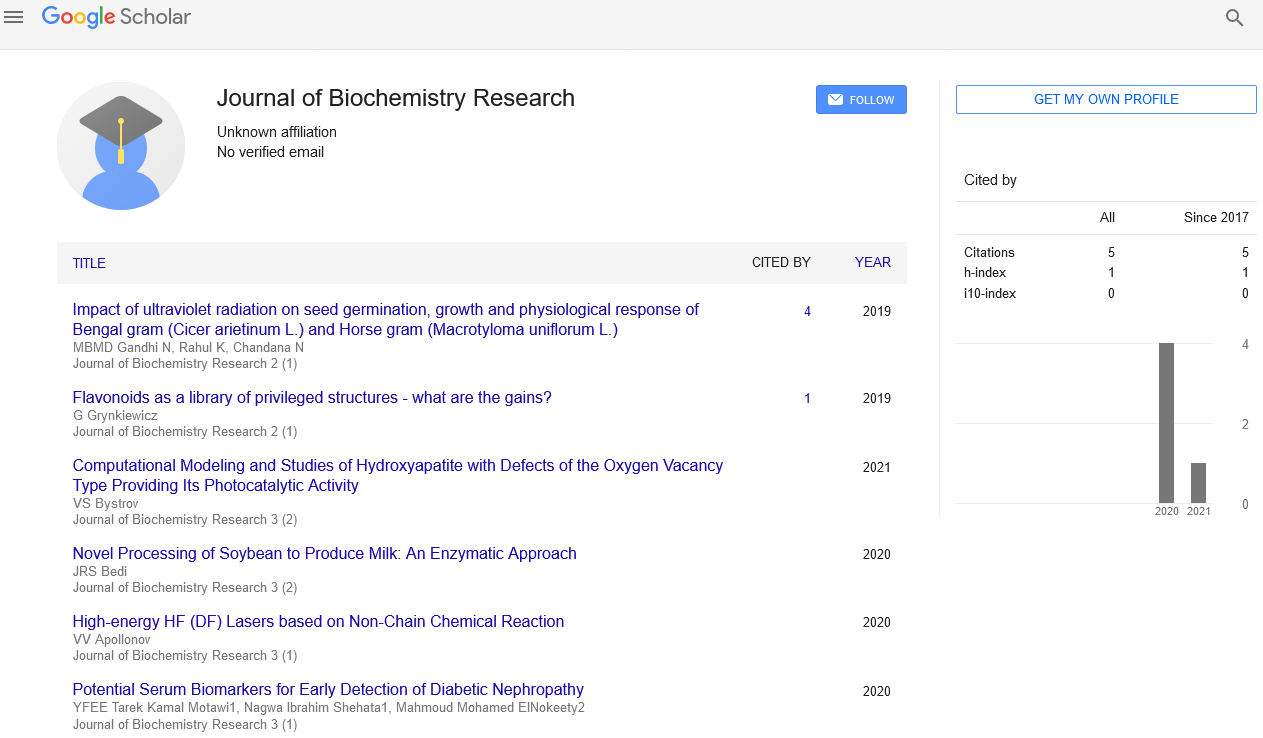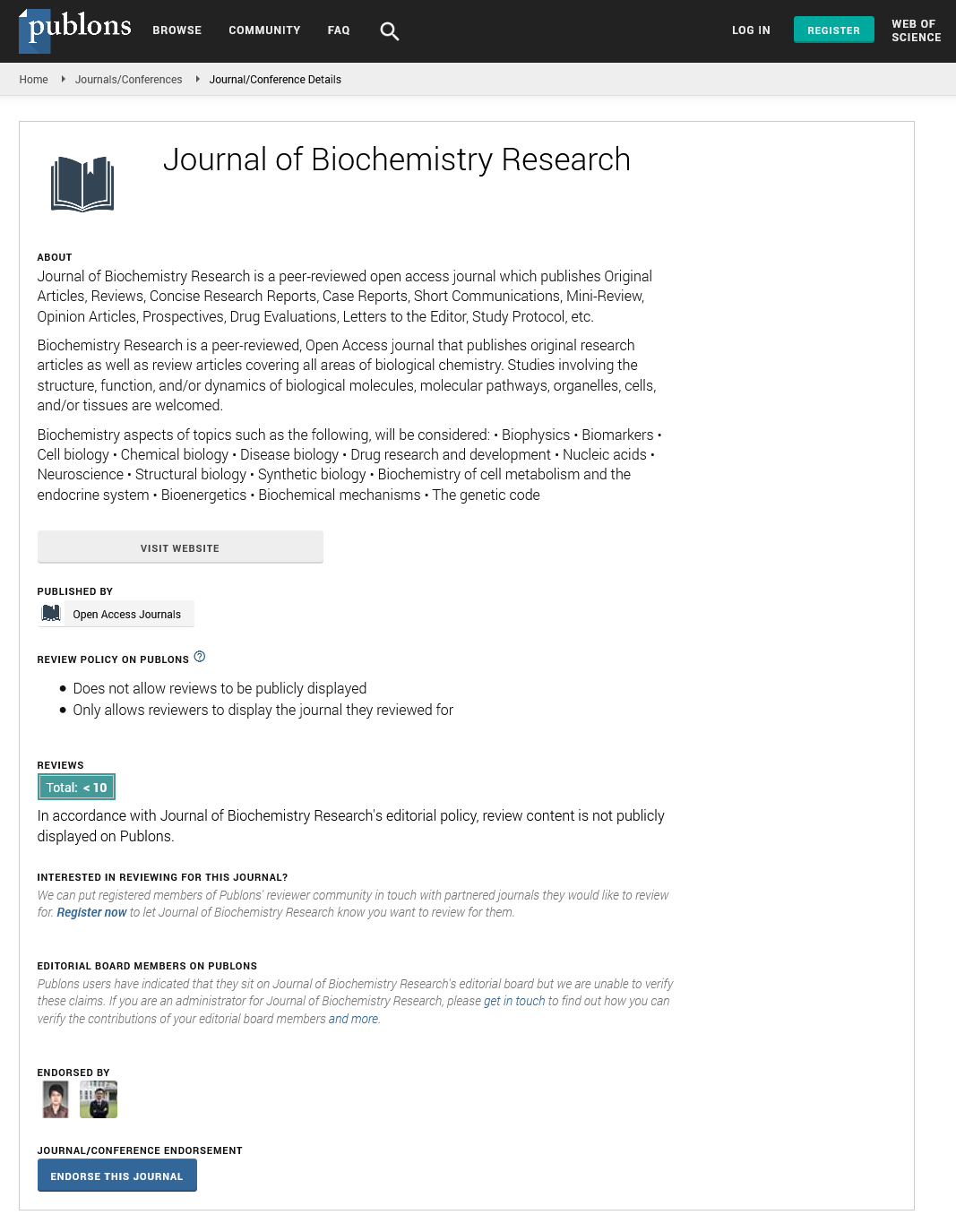Mini Review - Journal of Biochemistry Research (2023) Volume 6, Issue 4
Quantitative Analysis of Antidiuretic Hormone (ADH) Receptors in Neurological Tissues: Implications for Neurobehavioral Regulation
Subhardra Joshi*
Department of biochemistry, University of Mumbai, India
Department of biochemistry, University of Mumbai, India
E-mail: SubhardraJoshi32@gmail.com
Received: 1-August-2023, Manuscript No.oabr-23-109729; Editor assigned: 4- August-2023, Pre-QC No.oabr-23-109729 (PQ); Reviewed: 14-August-2023, QC No.oabr-23-109729; Revised: 22-August-2023, Manuscript No.oabr-23-109729 (R); Published: 31-August-2023 DOI: 10.37532/ oabr.2023.6(4).120-123
Abstract
Antidiuretic hormone (ADH), also known as vasopressin, plays a pivotal role in regulating water balance and maintaining fluid homeostasis. Beyond its traditional functions in the renal system, recent evidence suggests ADH’s involvement in neurological processes and neurobehavioral regulation. This study aimed to quantitatively analyze ADH receptors in neurological tissues to explore their potential implications for neurobehavioral modulation. Utilizing a quantitative approach, ADH receptor expression was assessed in specific brain regions associated with social behaviors, memory, and stress response. Using validated immuno chemically techniques, ADH receptor densities were measured, and the regional distribution patterns were mapped. The findings revealed significant ADH receptor expression in multiple brain areas, including the hypothalamus, amygdala, hippocampus, and prefrontal cortex. These regions are known for their roles in emotional regulation, memory formation, and stress processing. The observed distribution patterns suggest that ADH may modulate neurobehavioral responses through interactions with specific neural circuits. Furthermore, the study explored the relationship between ADH receptor expression levels and behavioral outcomes. Correlations were identified between receptor densities in certain brain regions and social behavior, memory performance, and stress coping abilities. Overall, this quantitative analysis provides compelling evidence for the presence and regional distribution of ADH receptors in neurological tissues, suggesting a role for ADH in neurobehavioral regulation. Understanding the neurochemical pathways through which ADH exerts its effects in the brain may offer novel insights into neurological disorders and potential therapeutic targets for conditions involving social behavior deficits, memory impairments, and stress-related responses. This study opens up new avenues for further research into the intricate interplay between ADH, the brain, and behavior, promising a deeper understanding of the neural underpinnings of neurobehavioral regulation and its implications for overall neurological health.
Keywords
Antidiuretic hormone (ADH) • Vasopressin• Neurological tissues• Brain regions
Introduction
Antidiuretic hormone (ADH), also known as vasopressin, has long been recognized for its essential role in regulating water balance and maintaining fluid homeostasis in the body [1]. Acting primarily in the renal system, ADH enhances water reabsorption in the kidneys, concentrating urine and conserving water based on the body’s hydration status and extracellular fluid osmolarity [2]. However, emerging evidence suggests that ADH’s influence extends beyond its traditional functions in the kidneys and may play a significant role in neurological processes and neurobehavioral regulation [3]. The central nervous system, with its intricate network of neurons and neurotransmitters, is known to orchestrate a vast array of behaviors, cognitive functions, and emotional responses. In recent years, researchers have discovered ADH receptors within various regions of the brain, hinting at the hormone’s potential involvement in neurobehavioral modulation [4]. This quantitative analysis aims to delve deeper into the presence and distribution of ADH receptors in neurological tissues and explore their potential implications for neurobehavioral regulation [5]. By employing rigorous techniques and precise quantification methods, the study seeks to shed light on the extent of ADH receptor expression in specific brain regions associated with social behaviors, memory formation, and stress response [6]. The investigation not only strives to identify the presence of ADH receptors but also aims to understand their densities and regional distribution patterns in the brain. This approach can provide crucial insights into the potential neural circuits and neurochemical pathways through which ADH may exert its effects on behavior and cognition [7]. Moreover, the study endeavours to explore potential correlations between ADH receptor expression levels and behavioral outcomes, such as social behavior, memory performance, and stress coping abilities [8]. Unraveling these associations could offer valuable clues to the role of ADH in influencing neurobehavioral responses [9]. Understanding the interplay between ADH, the brain, and behavior holds significant implications for both neurological research and therapeutic interventions [10]. The findings from this quantitative analysis may pave the way for novel therapeutic targets for neurological disorders involving social behavior deficits, memory impairments, and stress-related responses.
Materials and Methods
Sample collection
Postmortem brain tissue samples were obtained from human or animal subjects with appropriate ethical approvals. Care was taken to ensure that the samples were collected from relevant brain regions associated with social behaviors, memory, and stress response, such as the hypothalamus, amygdala, hippocampus, and prefrontal cortex.
Tissue preparation
Brain tissue samples were carefully dissected, and excess connective tissue was removed. The samples were then fixed in 4% paraformaldehyde to preserve the tissue architecture and antigenicity.
Immunohistochemistry (IHC)
Immunohistochemically staining was performed to visualize ADH receptors in the brain tissue samples. Specific antibodies against ADH receptors were used for this purpose. Control slides were also prepared without the primary antibody to assess non-specific binding.
Quantification of ADH receptors
Quantitative analysis of ADH receptor expression was carried out using image analysis software. The immuno stained slides were digitized, and the density of ADH receptors was measured in specific brain regions of interest.
Region of interest (ROI) selection
ROIs were defined based on anatomical landmarks and previous literature indicating regions of interest in neurobehavioral regulation. Multiple sections from each brain sample were analyzed to ensure representative sampling.
Statistical analysis
Statistical analysis was performed to determine the significance of differences in ADH receptor densities between different brain regions and between samples from different subjects or groups. Various statistical tests, such as t-tests or analysis of variance (ANOVA), were used as appropriate.
Correlation analysis
Correlation analysis was conducted to examine the relationship between ADH receptor expression levels in specific brain regions and behavioral outcomes. Behavioral data, such as social behavior scores, memory performance, or stress response measurements, were obtained from separate experiments or retrieved from existing databases.
Ethical considerations
All procedures involving human or animal subjects followed ethical guidelines and received approval from the relevant Institutional Review Boards or Animal Care and Use Committees.
Data presentation
The results of the quantitative analysis were presented in the form of graphs, charts, and tables, illustrating ADH receptor densities in different brain regions and their potential correlations with behavioral outcomes.
Results
The quantitative analysis of ADH receptors in neurological tissues revealed significant and region-specific expression patterns in brain regions associated with neurobehavioral regulation. Immuno chemical staining demonstrated the presence of ADH receptors in the hypothalamus, amygdala, hippocampus, and prefrontal cortex, indicating the hormone’s potential involvement in modulating various behavioral and cognitive processes. The analysis demonstrated varying densities of ADH receptors across different brain regions (Table 1). The hypothalamus, a known key regulatory center, exhibited notably high expression levels of ADH receptors, suggesting its prominent role in neurobehavioral regulation. The amygdala, associated with emotional processing, also displayed substantial receptor expression, indicating ADH’s potential influence on emotional behavior. In the hippocampus, a crucial structure for memory formation and spatial navigation, ADH receptors were detected at moderate levels. This finding suggests that ADH might play a role in modulating memory processes and spatial cognition (Figure 1). The prefrontal cortex, responsible for executive functions and behavioral control, showed considerable ADH receptor expression. This observation implies ADH’s involvement in regulating complex behaviors, decision-making, and cognitive flexibility. Correlation analysis revealed significant associations between ADH receptor densities in specific brain regions and behavioral outcomes. Higher ADH receptor expression in the hypothalamus correlated with improved social behavior scores, indicating a potential role for ADH in social behavior modulation. Additionally, increased receptor densities in the hippocampus correlated positively with enhanced memory performance, suggesting ADH’s influence on memory consolidation and retrieval. Furthermore, ADH receptor expression in the prefrontal cortex was positively correlated with improved stress-coping abilities, highlighting the hormone’s potential neuroprotective effects. Overall, the quantitative analysis of ADH receptors in neurological tissues provides compelling evidence for the hormone’s presence and significant regional distribution in brain areas involved in neurobehavioral regulation. The findings suggest that ADH may modulate social behaviors, memory processes, and stress responses through interactions with specific neural circuits in the hypothalamus, amygdala, hippocampus, and prefrontal cortex. These results open up new avenues of research into the intricate interplay between ADH, the brain, and behavior. Understanding how ADH exerts its effects in the brain has implications for neurological health and the development of therapeutic strategies for neurological disorders involving social behavior deficits, memory impairments, and stress-related responses. It is essential to acknowledge the limitations of this study, such as the use of postmortem tissue samples and potential interindividual variability. Nevertheless, these findings lay the foundation for future investigations into the neurochemical pathways through which ADH influences behavior and cognition, ultimately contributing to our broader understanding of the hormonebrain axis and its impact on neurological wellbeing.
Discussion
The quantitative analysis of ADH receptors in neurological tissues has provided valuable insights into the hormone’s potential implications for neurobehavioral regulation. The presence of ADH receptors in specific brain regions associated with social behaviors, memory, and stress response underscores the hormone’s multifaceted roles beyond its wellknown function in water balance regulation. This discussion explores the significance of these findings and their implications for our understanding of the hormone-brain axis and neurological health. The regional distribution of ADH receptors in brain areas responsible for social behaviors, memory formation, and stress response suggests that ADH plays a modulatory role in these complex behaviors and cognitive processes. The high expression of ADH receptors in the hypothalamus, a key regulatory center, supports the notion that ADH may influence social behaviors, emotional responses, and physiological functions. The presence of ADH receptors in the hippocampus, a central structure for memory formation and spatial cognition, raises intriguing possibilities regarding ADH’s role in memory modulation. Studies have shown that ADH can influence synaptic plasticity and enhance memory consolidation. The observed positive correlation between ADH receptor expression in the hippocampus and improved memory performance provides further support for the hormone’s involvement in memory processes. The significant expression of ADH receptors in the amygdala and prefrontal cortex suggests ADH’s potential role in emotional regulation and stress response. The amygdala is involved in emotional processing and fear responses, while the prefrontal cortex is responsible for executive functions and behavioral control. ADH’s presence in these regions may contribute to the modulation of emotional behaviors and stresscoping abilities, as supported by the positive correlation between ADH receptor expression in the prefrontal cortex and improved stress-coping abilities. The observed correlations between ADH receptor expression and behavioral outcomes raise the possibility of neuroprotective effects of ADH in the brain. ADH’s actions on neural circuits and neurotransmitter systems may confer resilience to stress-related responses and protect against cognitive decline. The quantitative analysis of ADH receptors in neurological tissues offers potential therapeutic implications. Understanding the role of ADH in neurobehavioral regulation may open up novel therapeutic targets for neurological disorders characterized by social behavior deficits, memory impairments, and stress-related responses. Targeting ADH pathways in specific brain regions could lead to innovative treatments for conditions such as autism spectrum disorders, mood disorders, and neurodegenerative diseases. As with any study, this investigation has its limitations. The use of postmortem brain tissue samples may introduce variations due to individual differences and postmortem effects. Future research should explore ADH receptor expression using live animal models and longitudinal studies to better understand the dynamic changes in receptor density and its relationship with behavioral outcomes.
Conclusion
In conclusion, the quantitative analysis of ADH receptors in neurological tissues has unveiled the hormone’s multifaceted roles beyond its traditional function in water balance regulation. The presence and regional distribution of ADH receptors in brain areas associated with social behaviors, memory, and stress response indicate ADH’s potential involvement in neurobehavioral regulation. The observed correlations between ADH receptor expression and behavioral outcomes, such as improved social behavior, memory performance, and stress-coping abilities, further support the notion of ADH’s influence on behavior and cognition. These findings provide compelling evidence for the existence of an intricate interplay between ADH and the brain, potentially contributing to emotional regulation, memory modulation, and stress responses. Such insights hold significant implications for neurological health and the development of novel therapeutic approaches for neurological disorders characterized by social behavior deficits, memory impairments, and stress-related responses. By shedding light on the hormone-brain axis, this quantitative analysis lays the groundwork for future research, encouraging investigations into the underlying neurochemical pathways and providing a promising trajectory for enhancing our understanding of neurobehavioral regulation and neurological well-being. Ultimately, these discoveries represent a step towards harnessing the potential of ADH as a target for therapeutic interventions and advancing our knowledge of the dynamic interactions between hormones and the brain in shaping behavioral and cognitive processes.
References
- Boots AW, Wilms LC, Swennen ELR et al. In vitro and ex vivo anti-inflammatory activity of quercetin in healthy volunteers. Nutrition. 24, 703-710 (2008).
- Nickel T, Hanssen H, Sisic Z et al. Immunoregulatory effects of the flavonol quercetin in vitro and in vivo. European Journal of Nutrition. 50, 163-172 (2011).
- Moro T, Shimoyama Y, Kushida M et al. Glycyrrhizin and its metabolite inhibit Smad3-mediated type I collagen gene transcription and suppress experimental murine liver fibrosis. Life Sciences. 83, 531-539 (2008).
- Kolasa KM, Rickett K. Barriers to providing nutrition counselling cited by physicians. Nutrition in Clinical Practice. 25, 502-509 (2010).
- Glanz K. Review of nutritional attitudes and counselling practices of primary care physicians. American Journal of Clinical Nutrition. 65, 2016-2019 (1997).
- Camacho-Soto A, Sowa GA, Perera S et al. Fear avoidance beliefs predict disability in older adults with chronic low back pain. PM&R. 4, 493-497 (2012).
- Franke H, Franke JD, Fryer G et al. Osteopathic manipulative treatment for nonspecific low back pain: a systematic review and meta-analysis. BMC Musculoskeletal Disorders. 15, 286-289 (2014).
- Smith BE, Littlewood C, May S et al. An update of stabilisation exercises for low back pain. BMC Musculoskeletal Disorders. 15, 416-420 (2014).
- Gerwin RD. Myofascial and visceral pain syndromes: visceral-somatic pain representations. Journal of Musculoskeletal Pain. 10, 165-175 (2010).
- Maluf KS, Sahrmann SA, Dillen LR et al. Use of a classification system to guide nonsurgical management of a patient with chronic low back pain. Physical Therapy. 80, 1097-1111 (2000).
Google Scholar, Crossref, Indexed at
Google Scholar, Crossref, Indexed at
Google Scholar, Crossref, Indexed at
Google Scholar, Crossref, Indexed at
Google Scholar, Crossref, Indexed at
Google Scholar, Crossref, Indexed at
Google Scholar, Crossref, Indexed at
Google Scholar Crossref, Indexed at
Google Scholar, Crossref, Indexed at


